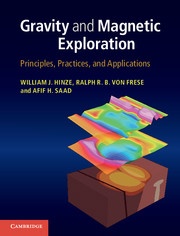Book contents
- Frontmatter
- Dedication
- Contents
- Preface
- Acknowledgements
- 1 Introduction
- Part I Gravity exploration
- 2 The gravity method
- 3 Gravity potential theory
- 4 Density of Earth materials
- 5 Gravity data acquisition
- 6 Gravity data processing
- 7 Gravity anomaly interpretation
- Part II Magnetic exploration
- Part III Applications
- Appendix A Data systems processing
- References
- Index
2 - The gravity method
from Part I - Gravity exploration
Published online by Cambridge University Press: 05 May 2013
- Frontmatter
- Dedication
- Contents
- Preface
- Acknowledgements
- 1 Introduction
- Part I Gravity exploration
- 2 The gravity method
- 3 Gravity potential theory
- 4 Density of Earth materials
- 5 Gravity data acquisition
- 6 Gravity data processing
- 7 Gravity anomaly interpretation
- Part II Magnetic exploration
- Part III Applications
- Appendix A Data systems processing
- References
- Index
Summary
Overview
The gravity method of geophysical exploration is based on the measurement of variations in the gravity field caused by horizontal variations of density within the subsurface. It is an important technique for many problems that involve subsurface mapping, and it is the principal method in a number of specific types of geological studies. The method, which has its roots in geodetic studies from the seventeenth to the twentieth centuries, has developed rapidly over the past century as a result of significant technological advances: primarily high-accuracy gravity measuring instruments for use on land, sea, and air, and in space, as well as the increasing computational and graphics power of digital computers. These advances are backed up by continuing improvements in data processing, interpretational schemes, practical experience, and surveying methodologies.
Traditionally the gravity method has been used primarily in regional characterization of the Earth for determining the architecture of the crust, identifying potentially favorable regions for resource exploration, and developing conceptual exploration models. This is made possible by the millions of gravity observations now available worldwide in both public and commercial data sets. The accuracy now available in gravity observations and the relative ease of measurement have made the method viable for exploration objectives such as assessing subsurface changes over time and combined interpretation with seismic reflection mapping.
Information
- Type
- Chapter
- Information
- Gravity and Magnetic ExplorationPrinciples, Practices, and Applications, pp. 19 - 37Publisher: Cambridge University PressPrint publication year: 2013
Accessibility standard: Unknown
Why this information is here
This section outlines the accessibility features of this content - including support for screen readers, full keyboard navigation and high-contrast display options. This may not be relevant for you.Accessibility Information
- 1
- Cited by
